From Habitability to Life on Mars » książka
topmenu
From Habitability to Life on Mars
ISBN-13: 9780128099353 / Angielski / Miękka / 2018 / 390 str.
Kategorie:
Kategorie BISAC:
Wydawca:
Elsevier
Język:
Angielski
ISBN-13:
9780128099353
Rok wydania:
2018
Ilość stron:
390
Waga:
0.67 kg
Wymiary:
23.5 x 19.05 x 2.06
Oprawa:
Miękka
Wolumenów:
01
Dodatkowe informacje:
Bibliografia











